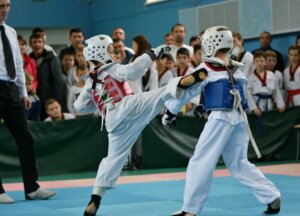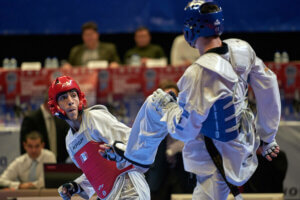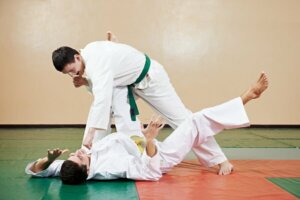The Rules of Taekwondo

The rules of taekwondo are some of the most specific in the world of martial arts. They’re not all that simple, as you’ll see if you watch it at the Olympics, for example. In fact, many viewers don’t really understand what’s going on in professional competitions.
Folded sleeves, straight cut, and protection – the rules are strict. Even though it’s a sport focused on punches and kicks, competitors must follow a strict code. Below are some of the most important rules of taekwondo.
Rules of taekwondo: scoring
In a taekwondo match, winning points involve striking various areas of the opponent’s body. Competitors need to make contact using their hands or feet with either the opponent’s head or torso. Where they strike and what type of technique they use will determine how many points they gain.
If a competitor strikes the opponent’s with a spinning kick, they’re awarded four points. Body twist kicks and regular head attacks add a further three points each. The lowest score is one point, for making strong contact with the opponent’s hogu (armor).
The rules of taekwondo basically give higher scores to those attacks which are the most difficult to carry out. This means that it’s not just the quantity of hits, but the quality and technique that you use. However, there are also things that you can’t do which will result in penalties.
Warnings: what you can’t do in taekwondo
There are at least 18 actions that can be penalized in Taekwondo, and they all relate to unfair or excessive behavior. There are even some penalties for avoiding confrontation.
The penalty system is simple and is divided according to the severity of the offense. Each time the referee signals a foul, the competitor loses a point.

A warning is known as a kyong-go and causes the fighter to lose half a point. A Gam-jeom is a penalty and is equal to one point.
List of fouls
The following actions are not allowed in the rules of taekwondo:
- Leaving the marked combat area.
- Avoiding confrontation by turning your back.
- Intentionally falling to the floor.
- Feigning injury during the match.
- Pulling back too far to avoid combat.
- Both competitors being passive for more than ten seconds.
- Attacking the opponent below the waist.
- Attacking with the knees or head.
- Hitting the opponent’s face with your hand.
- Holding or pushing your opponent.
- Blocking legal attacks using the knee.
- Making offensive comments.
- Interrupting combat or showing an obvious lack of attention to it.
- Attacking a fallen opponent.
- Hitting your opponent after the fight has stopped.
- Extreme behavior by one of the competitors.
Rules of taekwondo: knockouts
The first requirement for a knockout to be legal is that it needs to be the result of a legal attack. If any part of a participant’s body other than their feet touches the ground, they’re considered to be knocked down.
As a result, this means that even a slight wobble caused by legal contact can result in a competitor being knocked down. Then, if they cannot get back to their feet and continue within ten seconds, it’s ruled a knockout.
The referee can always judge whether the competitor is fit to continue. A knockout basically means that it would be dangerous to continue. There’s also a well-established procedure to stop a contest.

Well defined rules
The first rules of taekwondo were approved on May 28, 1973. From there, this regulation document has undergone 24 modifications, and the last one was in 2017. The federation that governs this sport worldwide is World Taekwondo.
The document contains different articles that establish the rules for each topic such as decisions, refereeing, dress code, and weight categories. There’s even a section for matters that aren’t specified in the competition rules.
Over time, updates have been required. For example, in the current regulations, there’s an article that addresses the use of video replay.
There’s also a section that considers people with hearing disabilities. Without a doubt, this is a disciplined sport, based on respect and some very, very strict rules.
The rules of taekwondo are some of the most specific in the world of martial arts. They’re not all that simple, as you’ll see if you watch it at the Olympics, for example. In fact, many viewers don’t really understand what’s going on in professional competitions.
Folded sleeves, straight cut, and protection – the rules are strict. Even though it’s a sport focused on punches and kicks, competitors must follow a strict code. Below are some of the most important rules of taekwondo.
Rules of taekwondo: scoring
In a taekwondo match, winning points involve striking various areas of the opponent’s body. Competitors need to make contact using their hands or feet with either the opponent’s head or torso. Where they strike and what type of technique they use will determine how many points they gain.
If a competitor strikes the opponent’s with a spinning kick, they’re awarded four points. Body twist kicks and regular head attacks add a further three points each. The lowest score is one point, for making strong contact with the opponent’s hogu (armor).
The rules of taekwondo basically give higher scores to those attacks which are the most difficult to carry out. This means that it’s not just the quantity of hits, but the quality and technique that you use. However, there are also things that you can’t do which will result in penalties.
Warnings: what you can’t do in taekwondo
There are at least 18 actions that can be penalized in Taekwondo, and they all relate to unfair or excessive behavior. There are even some penalties for avoiding confrontation.
The penalty system is simple and is divided according to the severity of the offense. Each time the referee signals a foul, the competitor loses a point.

A warning is known as a kyong-go and causes the fighter to lose half a point. A Gam-jeom is a penalty and is equal to one point.
List of fouls
The following actions are not allowed in the rules of taekwondo:
- Leaving the marked combat area.
- Avoiding confrontation by turning your back.
- Intentionally falling to the floor.
- Feigning injury during the match.
- Pulling back too far to avoid combat.
- Both competitors being passive for more than ten seconds.
- Attacking the opponent below the waist.
- Attacking with the knees or head.
- Hitting the opponent’s face with your hand.
- Holding or pushing your opponent.
- Blocking legal attacks using the knee.
- Making offensive comments.
- Interrupting combat or showing an obvious lack of attention to it.
- Attacking a fallen opponent.
- Hitting your opponent after the fight has stopped.
- Extreme behavior by one of the competitors.
Rules of taekwondo: knockouts
The first requirement for a knockout to be legal is that it needs to be the result of a legal attack. If any part of a participant’s body other than their feet touches the ground, they’re considered to be knocked down.
As a result, this means that even a slight wobble caused by legal contact can result in a competitor being knocked down. Then, if they cannot get back to their feet and continue within ten seconds, it’s ruled a knockout.
The referee can always judge whether the competitor is fit to continue. A knockout basically means that it would be dangerous to continue. There’s also a well-established procedure to stop a contest.

Well defined rules
The first rules of taekwondo were approved on May 28, 1973. From there, this regulation document has undergone 24 modifications, and the last one was in 2017. The federation that governs this sport worldwide is World Taekwondo.
The document contains different articles that establish the rules for each topic such as decisions, refereeing, dress code, and weight categories. There’s even a section for matters that aren’t specified in the competition rules.
Over time, updates have been required. For example, in the current regulations, there’s an article that addresses the use of video replay.
There’s also a section that considers people with hearing disabilities. Without a doubt, this is a disciplined sport, based on respect and some very, very strict rules.
All cited sources were thoroughly reviewed by our team to ensure their quality, reliability, currency, and validity. The bibliography of this article was considered reliable and of academic or scientific accuracy.
- Federación Mundial de Taekwondo. Reglamentación. Extraído de: https://www.fetaekwondo.net/images/2018/06/Reglamento-de-Competici%C3%B3n-e-Interpretaci%C3%B3n-1-de-Junio-2018.pdf
- Federación Española de Taekwondo. Extraído de: https://www.fetaekwondo.net/
This text is provided for informational purposes only and does not replace consultation with a professional. If in doubt, consult your specialist.








